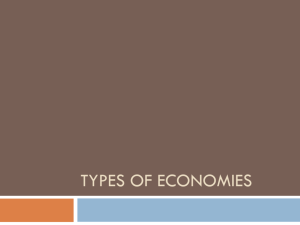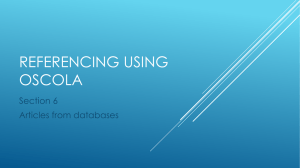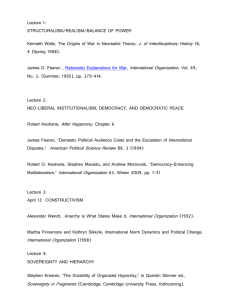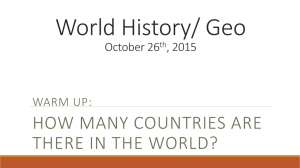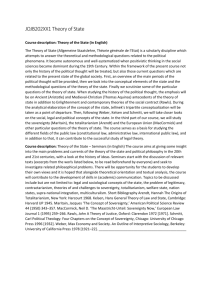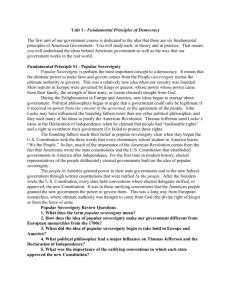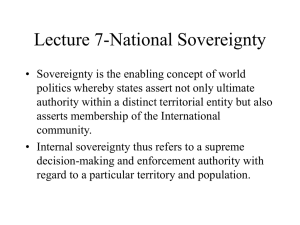Food Sov
advertisement
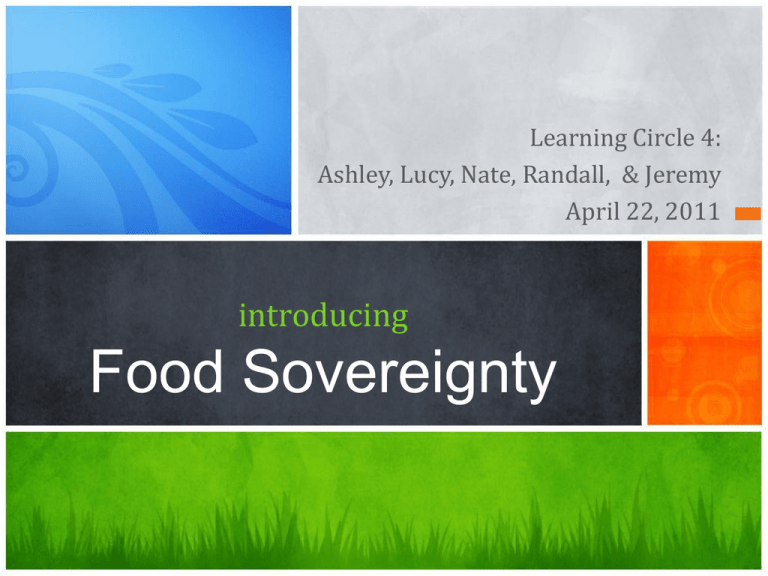
Learning Circle 4: Ashley, Lucy, Nate, Randall, & Jeremy April 22, 2011 introducing Food Sovereignty illars of Food Sovereignty 1. Food For People 4.Making Decisions Locally 2.Values Food Providers 5.Build Knowledge & Skills 3.Localizing Food Systems 6.Working with Nature ntegrating Dimensions of Food Sovereignty with Class Readings 1.Food for People Food for People FOOD SOVEREIGNTY STRESSES THE RIGHT TO SUFFICIENT, HEALTHY AND CULTURALLY APPROPRIATE FOOD FOR ALL INDIVIDUALS, PEOPLES AND COMMUNITIES, INCLUDING THOSE WHO ARE HUNGRY OR LIVING UNDER OCCUPATION, IN CONFLICT ZONES AND MARGINALIZED. FOOD SOVEREIGNTY REJECTS THE PROPOSITION THAT FOOD IS JUST ANOTHER COMMODITY FOR INTERNATIONAL AGRIBUSINESS. Source: www.foodsecurecanada.org Food is NOT a Commodity Agrofuels- “crime against humanity” Furthers commodification, capitalization, & corporatization of agriculture Patent Monopolies Farmer knowledge of ingenious crop and livestock threatened Estimate about $5 billion of royalties to developing countries for patented resources and knowledge Food Sovereignty gives the priority to food for people over industry. Challenges for Food Sovereignty Autonomy: Production and Consumption Suppan: Menezes: Food Sovereignty Patel: Food Sovereignty Wittman: The Origins & Potential of Food Sovereignty Food is NOT a just a Commodity The Price of Knowledge Exploitation Monsanto Bt cotton seed resulting 17,000 Indian farmer suicides Suppan: Challenges for Food Sovereignt People’s need for food first Preserving nutritional culture Food choices and cooking habits Melting Pot of cuisine Destroying cultural heritage Self-sufficiency due to eating habits Must be preserved Represents cultural identity 2.Valuing Food Providers Valuing Food Providers Role of Women Seed sovereignty Fair Trade & Fair Price Paul Nicholson, La vía campesina Valuing Food Providers: Providing equal access to knowledge and food to providers of food, providers of families, and anyone in a position to give. • Patel (2009) La vía campesina-and the right to have rights (especially for women). • Wittman (2010) “Contemporary food policies offer no real possibility for changing existing, inequitable, social, political, and economic structures.” • Menezes (2011) “The poorest groups are always the most vulnerable to a mass approach to nutrition,” or agriculture or information. 3.Localizing Food Systems Localizes Food Systems • Reduces distance between food providers and consumers – Collective decision-making among providers and consumers – Jaffee et al 2004: Limitations and deficiencies in current North-South focus of fair trade initiatives • Regional “solidarity markets” and “engaged localism” • Rejects dumping and inappropriate food aid – “Preserving nutritional culture” • Food aid based on globalized eating standards • Poor most vulnerable to generic concepts of nutrition – Menezes 2001: “Food as a political and economic weapon” Localizes Food Systems “Global agricultural food policies must be market-oriented… they must integrate agriculture into the global economy, not insulate us from it.” Former Sec. of Ag. Ann Veneman, 2001 • McMichael 2005: “Globalization as progressive realization of economic liberalization” • Food sovereignty resists dependency on distant corporations – Rejection of trade agreements that limit availability of locally and sustainably sourced foods – Avoids food policy that requires transfer of local powers to ensure adequate and equitable availability of food 4.Making Decisions Locally Puts Control Locally • Places control in the hands of local food providers – Wekerle’s (2004) Example: Toronto’s Food Policy Council • Established as part of a city department (not advisory) • Coordinates among a broad range of community food stakeholders – Menezes 2001: Four attributes affecting food availability require local control • • • • Sufficiency Stability Autonomy Sustainability Puts Control Locally • Recognizes a need to inhabit and share resources – Avoids market schemes as a means of efficiently distributing common pool resources • Rejects privatization of natural resources – Menezes 2001: “Resisting biopiracy and patenting of genetic resources” • Connects corporate takeovers of land, water, and seeds • Food aid connection: Transgenic soy and corn in aid supplies 5.Building Knowledge & Skills Food sovereignty builds on the skills and local knowledge of food providers and their local organizations that conserve, develop and manage localized food production and harvesting systems, developing appropriate research systems to support this and passing on this wisdom to future generations – Foodsecurecanada.org The problem • Opposite of local knowledge • Mega corporations in control of agribusiness • Challenges for food sovereignty (Suppan,2008) Tobacco Buyout 1998 Settlement $ 206 billion dollars NC $4.6 billion over 25 years Tobacco Trust fund Commission Assist tobacco farmers and quota holders due to affects of the settlement • Disperse funds through compensatory programs and qualified Ag programs • • • • • Sustainable Agriculture Tool Lending Library 6.Working with Nature Principle Six: Works with nature, rather than using methods that harm beneficial
